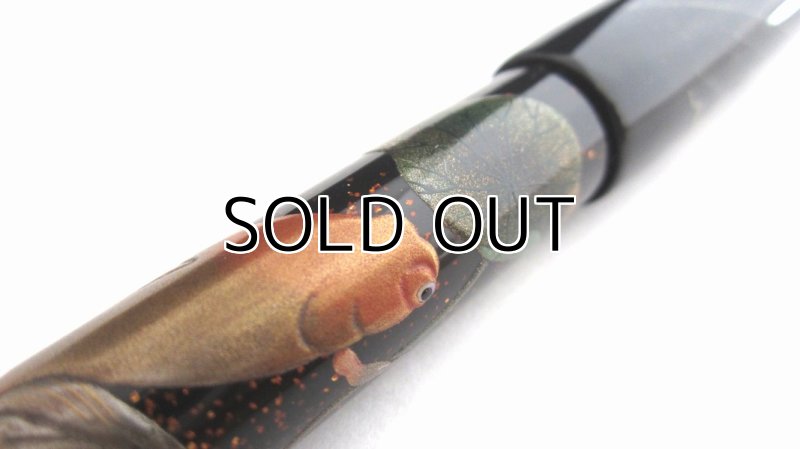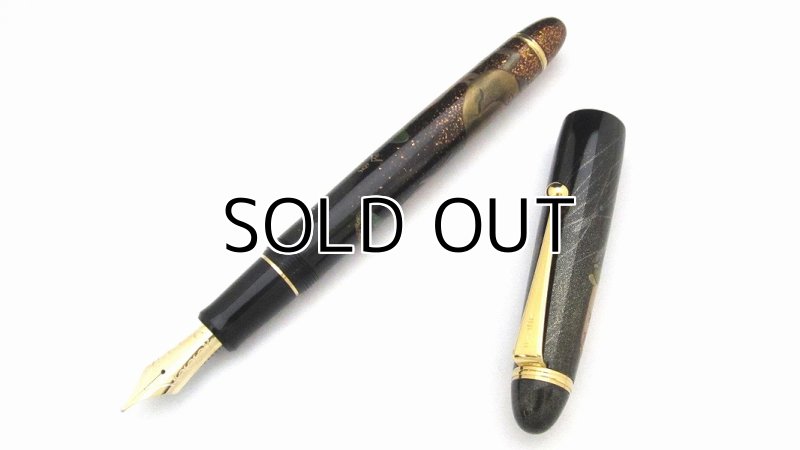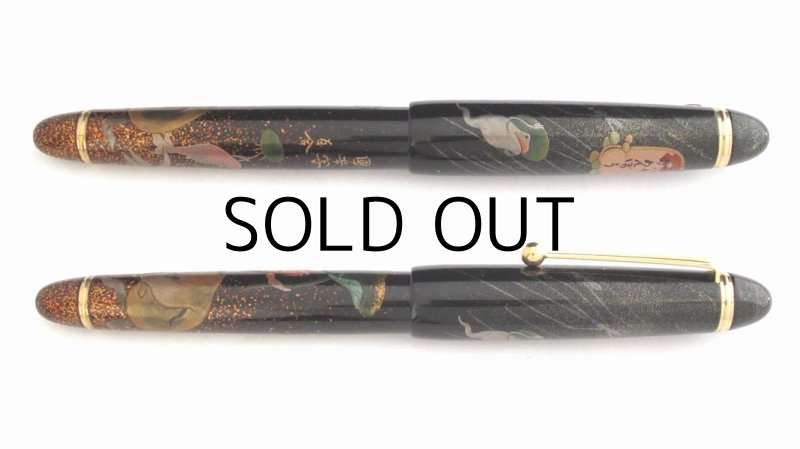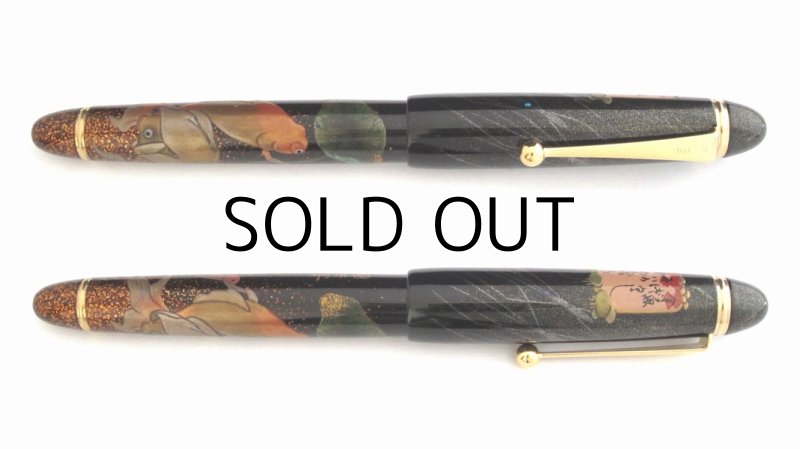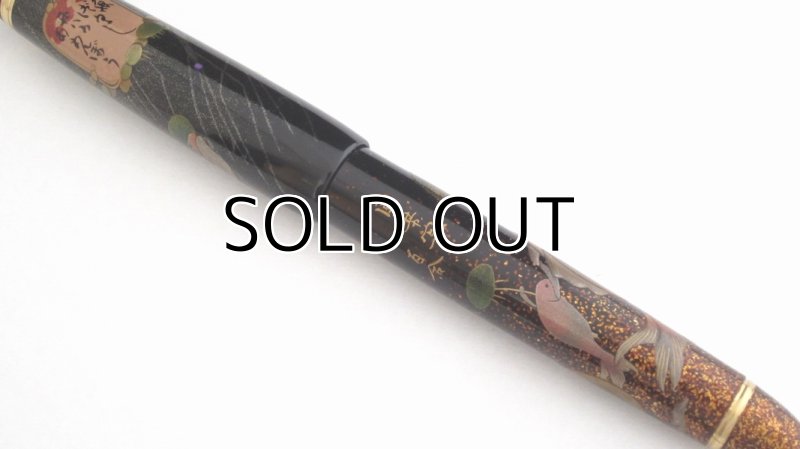AGJ Original Maki-e Fountain pen #26 "Goldfish" Sparkling Togidashi Taka Maki-e Kyoto Japan Wa
AGJ Original Maki-e Fountain pen #26 "Goldfish" Sparkling Togidashi Taka Maki-e Kyoto Japan Wa
Please contact us from here for the price.
Item Description
This AGJ original Maki-e Fountain pen is made by famous Kyoto Maki-e Artisan "Yuri".
This pen is only one in the world. You can not find it anywhere.
Kyoto Maki-e is the best known Maki-e technique in Japan.
This is original Maki-e fountain pen based on a Japanese fountain pen.
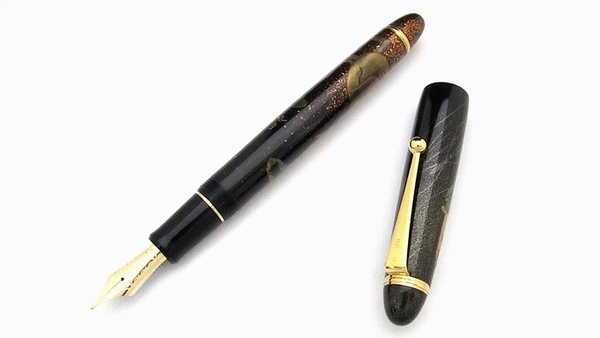
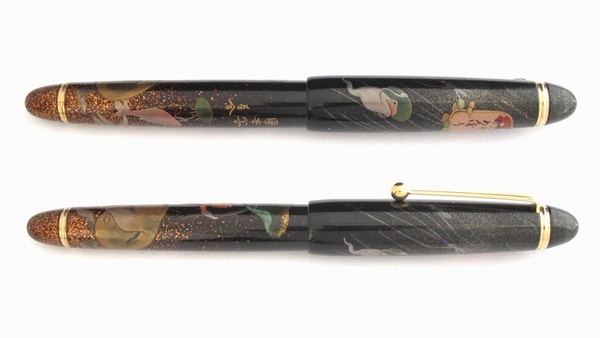

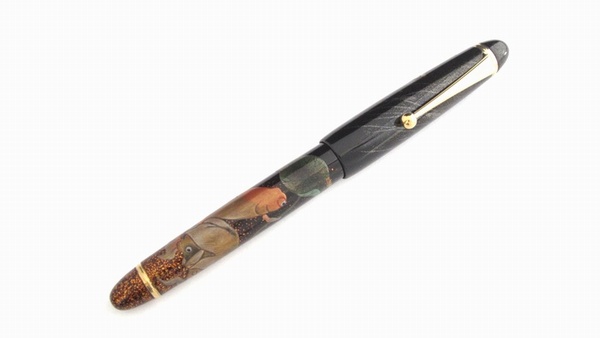
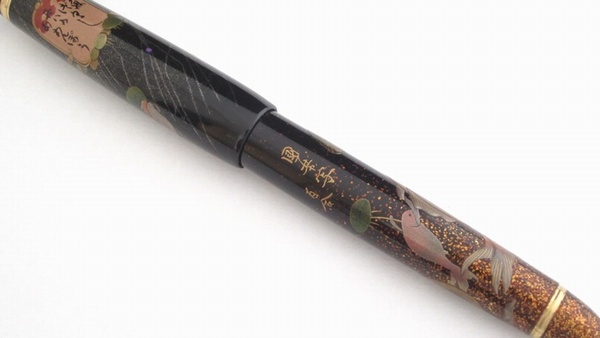
Relatively rough Gold Nashiji powders are sprinkled over the background on the barrel. The result is less flashy as Nashiji powders create less glittery results than Hirame powders (they do not polish lacquer completely). Nashiji powders are chosen in order to express the pebbles in the bottom of the water.
A water strider on the cap was created with Togidashi Makie technique. The base for the title (which separates the red part from the pink part) was burnished with the water strider at the same time when the water slider was processed. After the process was complete, green water weed on the title was raised.
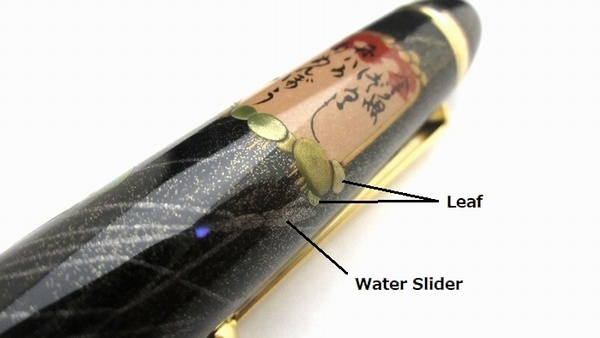
Water Slider: Togidashi Maki-e
Head: Abalone shells
Legs: Silver powders
The Background: Blue gold powders
Leaf: Taka Maki-e
Blue gold powders
Some parts coated with green lacquer
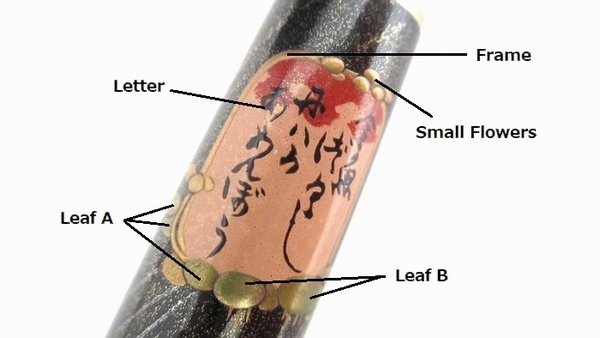
Base (which separates the pink part from the red part): Togidashi Maki-e
Gold powders
Letter:
Black urushi lacquer
Frame: Taka Maki-e
Gold powders
Small Flowers: Taka Maki-e
Gold powders
Leaf A: Taka Maki-e
Blue gold powders
Some parts coated with green lacquer
Leaf B: Taka Maki-e
Gold powders
Some parts coated with green lacquer
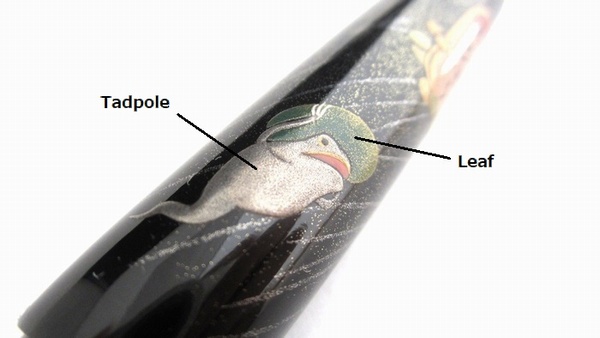
Tadpole: Taka Maki-e
Body: Silver powders
While the mouth: Colored lacquer
The framing part of the mouth: Gold powders
Leaf: Taka Maki-e
Gold powders are coated with green lacquer
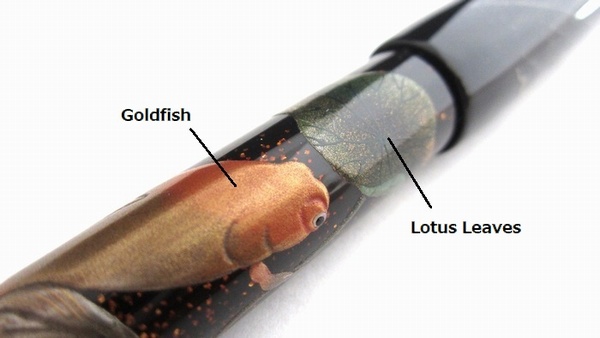
Goldfish
Gold powders
Some parts are coated with Red and Black urushi lacquer
Lotus Leaves
Gold powders
Some of silver powders sprinkled
Green colored lacquer
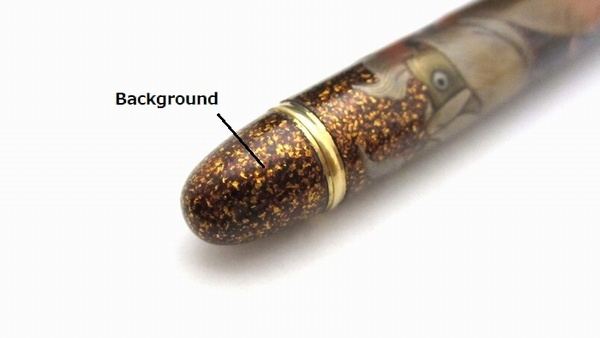
Background:
Gold Nashiji powders
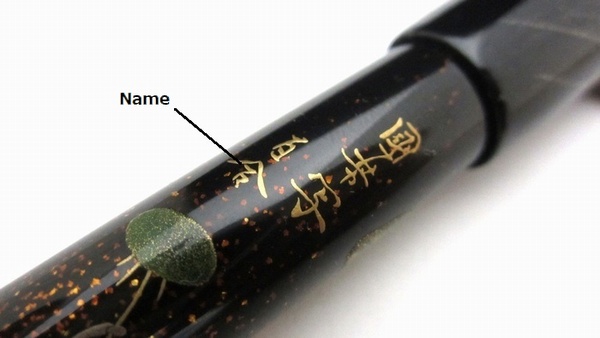
Name: Hira Maki-e
Gold powders
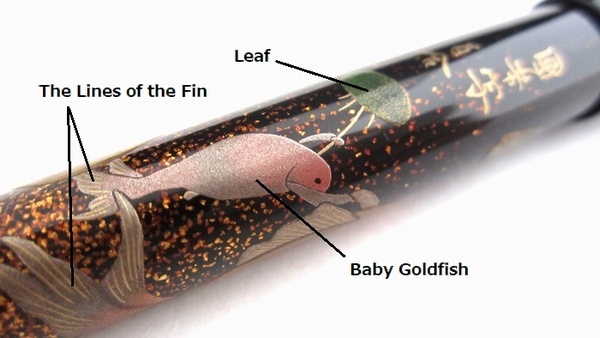
Baby Goldfish: Hira Maki-e
Silver powders
Some parts are coated with Red urushi lacquer
Leaf: Hira Maki-e
Gold powders are coated with green lacquer
The lines of the Fin: Hira Maki-e
Gold powders
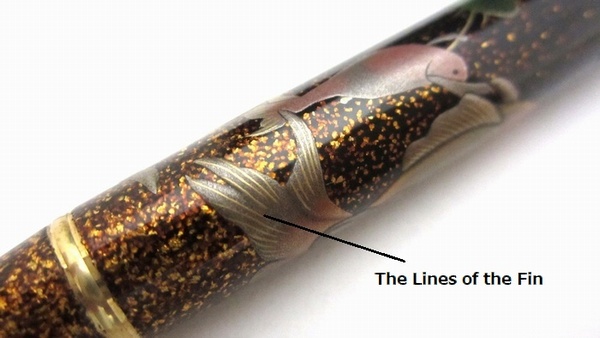
The lines of the Fin: Hira Maki-e
Gold powders
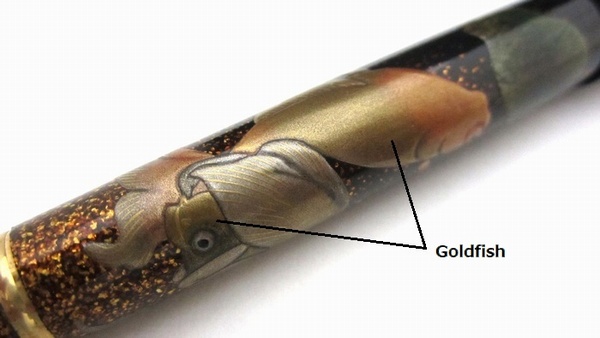
Goldfish
Gold powders
Some parts are coated with Red and Black urushi lacquer
[Description]
This pen is only one in the world. You can not find it anywhere.
Kyoto Maki-e is the best known Maki-e technique in Japan.
This is original Maki-e fountain pen based on a Japanese fountain pen.





Relatively rough Gold Nashiji powders are sprinkled over the background on the barrel. The result is less flashy as Nashiji powders create less glittery results than Hirame powders (they do not polish lacquer completely). Nashiji powders are chosen in order to express the pebbles in the bottom of the water.
A water strider on the cap was created with Togidashi Makie technique. The base for the title (which separates the red part from the pink part) was burnished with the water strider at the same time when the water slider was processed. After the process was complete, green water weed on the title was raised.

Water Slider: Togidashi Maki-e
Head: Abalone shells
Legs: Silver powders
The Background: Blue gold powders
Leaf: Taka Maki-e
Blue gold powders
Some parts coated with green lacquer

Base (which separates the pink part from the red part): Togidashi Maki-e
Gold powders
Letter:
Black urushi lacquer
Frame: Taka Maki-e
Gold powders
Small Flowers: Taka Maki-e
Gold powders
Leaf A: Taka Maki-e
Blue gold powders
Some parts coated with green lacquer
Leaf B: Taka Maki-e
Gold powders
Some parts coated with green lacquer

Tadpole: Taka Maki-e
Body: Silver powders
While the mouth: Colored lacquer
The framing part of the mouth: Gold powders
Leaf: Taka Maki-e
Gold powders are coated with green lacquer

Goldfish
Gold powders
Some parts are coated with Red and Black urushi lacquer
Lotus Leaves
Gold powders
Some of silver powders sprinkled
Green colored lacquer

Background:
Gold Nashiji powders

Name: Hira Maki-e
Gold powders

Baby Goldfish: Hira Maki-e
Silver powders
Some parts are coated with Red urushi lacquer
Leaf: Hira Maki-e
Gold powders are coated with green lacquer
The lines of the Fin: Hira Maki-e
Gold powders

The lines of the Fin: Hira Maki-e
Gold powders

Goldfish
Gold powders
Some parts are coated with Red and Black urushi lacquer
| Name: | Goldfish #26 (Pilot Namiki Original) |
| Maki-e Artist: | Yuri |
| Technique: | Togidashi Taka Maki-e |
| Origin: | Kyoto, Japan |
| Nib: | 14K Gold #15 |
| Nib size: | Medium, Bold (If you like other nib size, please let us know.) |
| Size: | 15.7mm(Dia.) x 149mm |
| weight: | 26g |
| Shipping: | FREE SHIPPING! |
| Others: | AGJ Original Design Maki-e With CON-70 converter |
Custom engraving service on AGJ original Maki-e fountain pens is available for those who wish.
- The lead time: it takes 10-14 days on top (orders without this service will be usually dispatched in 3-5 days after confirming the payment).
- The cost: US$100.00.
- The letters of the name engraved will be engraved in gold just as the signature of the Makie artisans of Original fountain pens.
- Please send us the sample letters which you wish to engrave on the pen (there could be a case where we are unable to engrave the letters of your choice after consulting with the Makie artisans. Letters can be in Japanese Kanji, Katakana and Hiragana but if you choose Kanji, we will use phonetic symbols).
- Please indicate the exact position where you wish to have your name engraved (please understand that there could be a case where we may have to change the position of engraving after consulting with the Makie artisans).
[Yuri's Career]
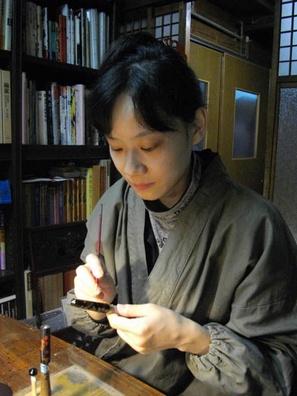
| Year 1981 | Born in Kyoto |
| 2001 | She followed the family trade of Lacquered tea utensils making and started to work at Studio "Manju" owned by her family. She took charge of design and decoration of Lacquered.work (Maki-e). She also studied the traditional Japanese Painting at Kyoto University of Art and Design. |
| 2009 | The Japanese lacquered tea ware (Usuchaki) made by her won the Kyoto Governor Prize at the 40th Kyo Laquered Ware Exhibition (the prize was won under the Studio's name). Her work was also selected for the 49th Japan Crafts Exhibition. |
